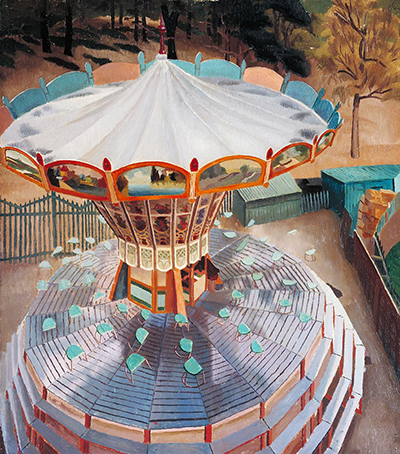Who, these days, has not at one point or another glanced out of a window and seen something that is aesthetically pleasing or nostalgic or simply satisfying and felt the need to snap a picture to preserve if not the moment, then the memory of the moment?
Few, is probably the answer. Many of Stanley Spencer's works seem to be like this: frozen moments of time, nothing huge or important or weighty, but just things he saw and liked – and chose to immortalise in paint and canvas rather than with light and paper (or device, as would be used today). This is one of his many images that capture the things he saw daily during his daily rounds to and from work, visiting friends or simply strolling the streets to see what there was to be observed. The Roundabout is the view of the eponymous fairground equipment as seen from the fourth or fifth floor of a building, in this case the top floor of the Vale Hotel, where Henry Lamb, Spencer's contemporary, had his studio.
Spencer painted the work in situ, finding inspiration from Hampstead Heath's fairground which was, as can be seen in the image, just outside of the window. One can almost imagine the two artists hearing the evocative call of the calliope as they conversed, and drifting over to the window to discuss fairgrounds, their best loved memory of rides and wonder if toffee apples still taste as good as they did in youth. The roundabout is a relatively simple one: a flat surface with a number of seats bolted onto it, while above an ornately pointed roof gives a hint of exotic adventure – accentuated by the careful depiction of various scenes on each of the many facia panels of the roundabout's roof.
The roof is peaked, almost giving the impression of a circus tent, while an air of benign neglect is evoked with the operator's chair standing empty near the apparatus, the ground marred by a handkerchief or piece of paper that lies near the seat. The roundabout is empty yet somehow expectant, and the viewer finds themselves staring into the painting, waiting and hoping that the roundabout will begin to turn, the music will start up and the barker's calls will bring a horde of excited and squealing patrons all hastening to score a seat on one of the chairs before the ride begins. This painting, in oil on canvas, can be found in the Tate Gallery.




